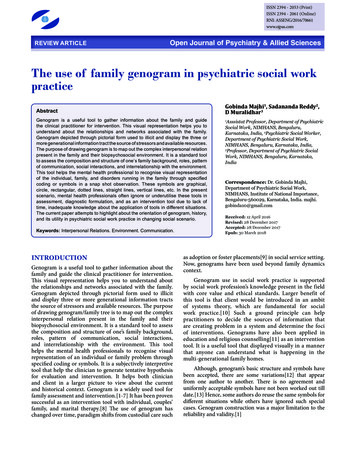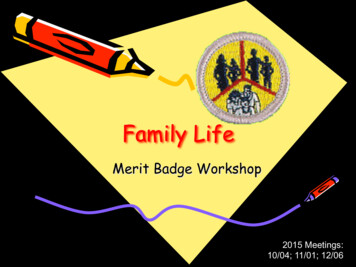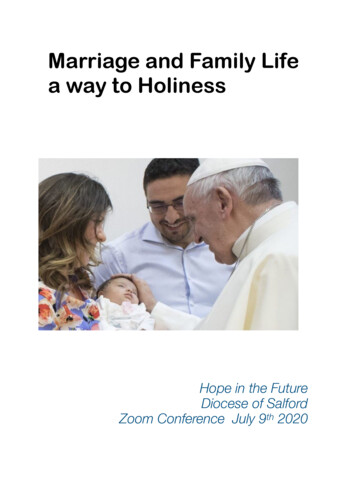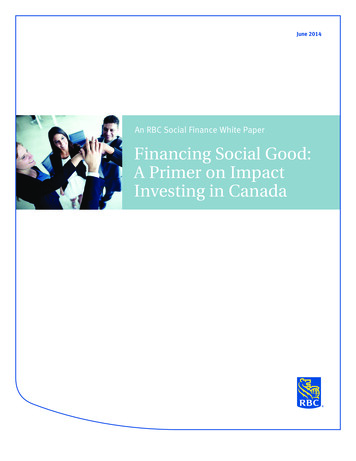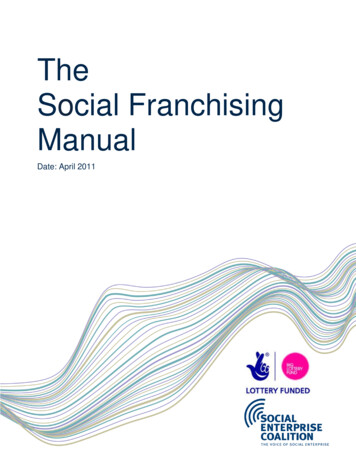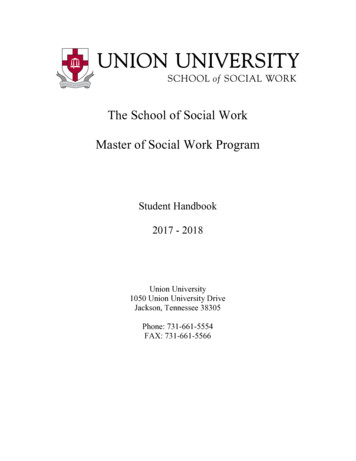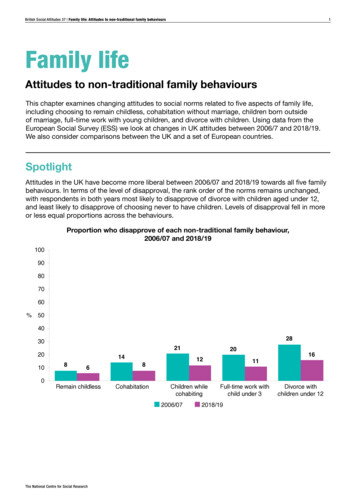
Transcription
British Social Attitudes 37 Family life: Attitudes to non-traditional family behaviours1Family lifeAttitudes to non-traditional family behavioursThis chapter examines changing attitudes to social norms related to five aspects of family life,including choosing to remain childless, cohabitation without marriage, children born outsideof marriage, full-time work with young children, and divorce with children. Using data from theEuropean Social Survey (ESS) we look at changes in UK attitudes between 2006/7 and 2018/19.We also consider comparisons between the UK and a set of European countries.SpotlightAttitudes in the UK have become more liberal between 2006/07 and 2018/19 towards all five familybehaviours. In terms of the level of disapproval, the rank order of the norms remains unchanged,with respondents in both years most likely to disapprove of divorce with children aged under 12,and least likely to disapprove of choosing never to have children. Levels of disapproval fell in moreor less equal proportions across the behaviours.Proportion who disapprove of each non-traditional family behaviour,2006/07 and 2018/1910090807060%504030201008146Remain childless218Cohabitation2012Children whilecohabiting2006/07The National Centre for Social Research2811Full-time work withchild under 32018/1916Divorce withchildren under 12
British Social Attitudes 37 Family life: Attitudes to non-traditional family behavioursOverviewChanging attitudes to family behaviourAttitudes in the UK have become more liberal between 2006/07 and 2018/19 towards all fiveof the family behaviours we asked about. Between 2006/07 and 2018/19, the proportion disapproving fell for remaining childless from8% to 6%, for having children while cohabiting from 21% to 12%, and for divorcing while achild was younger than 12 from 28% to 16%. In both years people were most likely to disapprove of divorce with children aged under 12,and least likely to disapprove of choosing never to have children. Alongside the continuing declines in disapproval, there have been substantial decreases inthe proportion who neither approve nor disapprove, resulting in increases of more than 20percentage points in those approving of childlessness, cohabitation (in general and with achild) and divorcing while a child is under 12.Generations and social normsChanges in attitudes to non-traditional family behaviours can operate through the changingcomposition of the population over time. The passing of the generation born before 1928 has contributed to the overall decline indisapproval. Disapproval of divorce with children under 12, and of working full-time with young children,has fallen between 2006/07 and 2018/19 among every birth cohort in the sample.Comparisons between the UK and EuropeIn the UK and across a range of European countries, the direction of travel is towards a lessprescriptive, more laissez-faire attitude among the public towards fertility and family choicesby both men and women. Disapproval of childlessness, cohabitation and having children outside marriage has fallensharply in every country represented in the data. Countries in eastern Europe remain more disapproving of these behaviours than elsewhere. Disapproval of working full-time with young children is lower overall and less differentiatedbetween countries. The UK has a similar attitudinal profile on these questions to Nordic countries and theNetherlands.The National Centre for Social Research2
British Social Attitudes 37 Family life: Attitudes to non-traditional family behavioursAuthorsEric HarrisonSenior Lecturer in QuantitativeSociology at City, University of London,and Deputy Director of the EuropeanSocial Survey3IntroductionThis chapter examines changing attitudes to social norms relatedto a number of aspects of family life, including choosing to remainchildless, cohabitation without marriage, children born outsideof marriage, full-time work with young children, and divorce withchildren. First, it discusses the concept of social norms and theirrole within debates about society and politics. Second, it describesthe dataset on which the chapter is based, namely the EuropeanSocial Survey (ESS), the ‘timing of life’ module that has been fieldedtwice on the ESS twelve years apart (on ESS round 3 in 2006/7, andon ESS round 9 in 2018/19), and the specific items upon which theanalysis is performed. Third, it presents findings on family norms inthe UK and comparisons with a set of European countries. A shortfourth section concludes.Social norms and the ‘Family’Social norms are the sets of values, behaviours and unwritten rulesthat govern behaviour in groups and societies. They are regarded asrepresentations of acceptable behaviour. Social norms have had animportant place in sociology since the nineteenth century, and in sociallife for far longer. Durkheim (1893) argued that such norms were crucialto maintaining social cohesion in the urban and industrial societies thatwere emerging at the time. In order to prevail, these norms requiredeither widespread consensual support, or a system of sanctions forthose who did not conform. In traditional societies the Church oftentook on the role as enforcer of social norms; in modern, more secularsocieties, this role is associated more with the legal system andbureaucracy acting on behalf of the state. At more micro-levels ofsociety, most local communities and voluntary associations use socialnorms to maintain their cohesion. In fact it is difficult to think of any ‘ingroup’ that does not have stated social norms which it enforces.For as long as there have been social norms there has probably beenconcern about their erosion or total breakdown. The sociology ofdeviance is a catalogue of ‘dangerous’ out groups (young people, anynumber of sub-cultures, and latterly migrants) that are thought tohave threatened the cohesion of society. A different sort of threat,and the one that is the subject of this chapter, has been a perceiveddecline in standards of personal morality, manifested in thebreakdown of the traditional nuclear family and behavioural normsassociated with it. These concerns go back at least as far as the‘permissive society’ of the 1960s and reached their apogee in the1990s with the short-lived and ill-fated ‘Back to Basics’ slogan of thethen Conservative government.In sociological terms, the weakening of many of these traditionalmoral, lifestyle and life-course norms stems from the secularisationthat was ushered in by a century of industrialisation and urbanisation.These economic processes also transformed the meaning and role ofThe National Centre for Social Research
British Social Attitudes 37 Family life: Attitudes to non-traditional family behaviours4the family as an economic unit. The norms around family and fertilityare very divisive. Those of a liberal inclination praise the new freedomof individuals (mostly female) to make their own choices about lifeevents such as childbearing and childrearing, not to mention themore diverse range of family models on offer beyond the traditionaltwo-parent model that was dominant until the 1960s. On the otherhand, many social conservatives hold the ‘breakdown of the family’ tobe at the heart of a range of social ills, ranging from low educationalattainment of children in one-parent families to criminality amongyoung men growing up without male role models. The expansion offemale labour force participation, and the accompanying increase inthe number of dual-worker households, are also criticised byconservative commentators for undermining traditional gender rolesand family stability.It is worth remembering that each of the five norms that arediscussed in this chapter (childlessness, cohabitation withoutmarriage, children born outside of marriage, full-time work with youngchildren, and divorce with children) were, until relatively recently,strongly policed and their transgression involved considerable(frequently gendered) stigma. Women who remained childlessattracted the uncomplimentary epithet ‘spinster’. Those who chose tocohabit might be described as ‘living over the brush’, or ‘living in sin’.Children born out of wedlock were labelled as ‘illegitimate’ (or worse)and their families would go to considerable lengths to mitigate orconceal this fact – the ‘shotgun wedding’ is an allusion to suchmitigations – and it was not unknown for single women to give a babyup for adoption, or exceptionally to allow the child to be raised byanother relative. As late as the 1980s, children with working parentswho returned from school to an empty house might still be referred toas ‘latch-key kids’. Finally, the phrases ‘staying together for thechildren’ and ‘coming from a broken home’ give some indication ofthe prevailing attitudes to divorce and its effects on children.Attitudes to these issues have steadily ‘loosened’ since the 1980s. Areview of the British Social Attitudes data in the thirty years after 1983concluded that there was an increasing sense of ‘live and let live’when it comes to our views on other people’s relationships andlifestyles. It noted that “generational trends make it likely that thisshift will continue, although it is important to recognise that eventscan upset even seemingly long-term and deep-rooted shifts inopinion” (Park et al., 2013:19). The 2010s have been marked by therise of populist political movements, many of which hold sociallyconservative views and promote adherence to more traditionalvalues. The decision of the UK to leave the European Union in 2016reversed a forty-year trend towards greater integration with thecontinent. Events can have an impact on seemingly inexorable trends.At the same time, many of the once stigmatised behaviours outlinedabove are now far more common than they once were. In the UK,between 2008 and 2018 the number of cohabiting couple familiesincreased from 2.7 to 3.4 million (representing about 18% of allThe National Centre for Social Research
British Social Attitudes 37 Family life: Attitudes to non-traditional family behaviours5families). Lone parent families account for 2.9 million of all families(15%). Between 1996 and 2017 the proportion of dependent childrenliving in cohabitating households rose from 7% to 15% (ONS, 2017,2018). Slightly more than a fifth live in lone-parent families, though theproportion has changed little in the last two decades. Of course, thefact that a phenomenon is widespread is not in itself a sign of moralapproval, but the greater visibility it has in public life and the morecommon it becomes as a personal experience, the more it becomesa de facto norm.The importance of social norms around family life for key life-coursedecisions (and the potential reproduction or disruption of the norms)has been noted in the relevant literature (Liefbroer et al., 2010), as hasthe gendered nature of patterns of disapproval in relation tochildlessness, of working full-time while having children, and of thefamily life course in general (Rijken and Merz, 2014). These papers allemphasise the presence of the ‘gendered double standard’, in otherwords that there is a difference in society’s views towards thebehaviour of men and women. This implies a residual traditionalism inrespect of gender roles within the broader liberalising trend.Given that attitudinal changes to social norms were already evident atthe beginning of the twenty-first century, and that the prevalence ofthose norms has continued to erode in the last two decades, the restof this chapter addresses four questions. First, has the slow tide ofliberalisation continued in relation to attitudes to personal moralityand lifestyles? Second, are there any differences between specifictypes of behaviour or are they all subject to an increase ingeneralised social tolerance? Third, have gendered double standardsfaded or do they persist? Fourth, is there continued evidence of a‘generational effect’ or are attitudes changing throughout thepopulation?The dataThe data on which the analysis is based is drawn from two rounds ofthe European Social Survey (ESS). First conceived in the mid-1990s,the ESS is a cross-sectional cross-national general social survey,carried out every two years in a large number of countries – 38 haveparticipated in at least one round and 14 have done so in every roundsince its inception in 2002.1Round 3 of the European Social Survey included a module on ‘TheTiming of Life: The Organisation of the Life Course in Europe’. InRound 9 a subset of the original module was fielded again (for a fulldescription of the module’s aims and content see European SocialSurvey, 2018).1 Unlike the BSA series which draws a representative sample of those aged 18 years and over,the ESS draws a representative sample of the population aged 15 and over in each participatingcountry. This chapter reports on data from the UK (including Northern Ireland which is notincluded in BSA), as well as other ESS countries. Fieldwork for ESS Round 3 was carried out in2006/2007, and for Round 9 in 2018/2019.The National Centre for Social Research
British Social Attitudes 37 Family life: Attitudes to non-traditional family behaviours6The concept of norms about family behaviour was measured by a setof five items. These were asked as follows:How much do you approve or disapprove if a woman/man chooses never to have children? lives with a partner without being married? has a child with a partner she/he lives with but is notmarried to? has a full-time job while she/he has children aged under 3? gets divorced while she/he has children aged under 12?Respondents could answer on a 5-point scale ranging from ‘stronglyapprove’ to ‘strongly disapprove’. Half the sample was randomlyassigned to be asked the questions with references to a woman, andhalf to a man.Changing attitudes to family behaviour inthe UKNorm by norm analysisWhile the five items can be thought of as measuring an underlyingconcept (norms about family behaviour) we would still expec
37 Family life: Attitudes to non-traditional family behaviours 1 This chapter examines changing attitudes to social norms related to five aspects of family life, including choosing to remain childless, cohabitation without marriage, children born outside of marriage, full-time work with young children, and divorce with children. Using data from the
